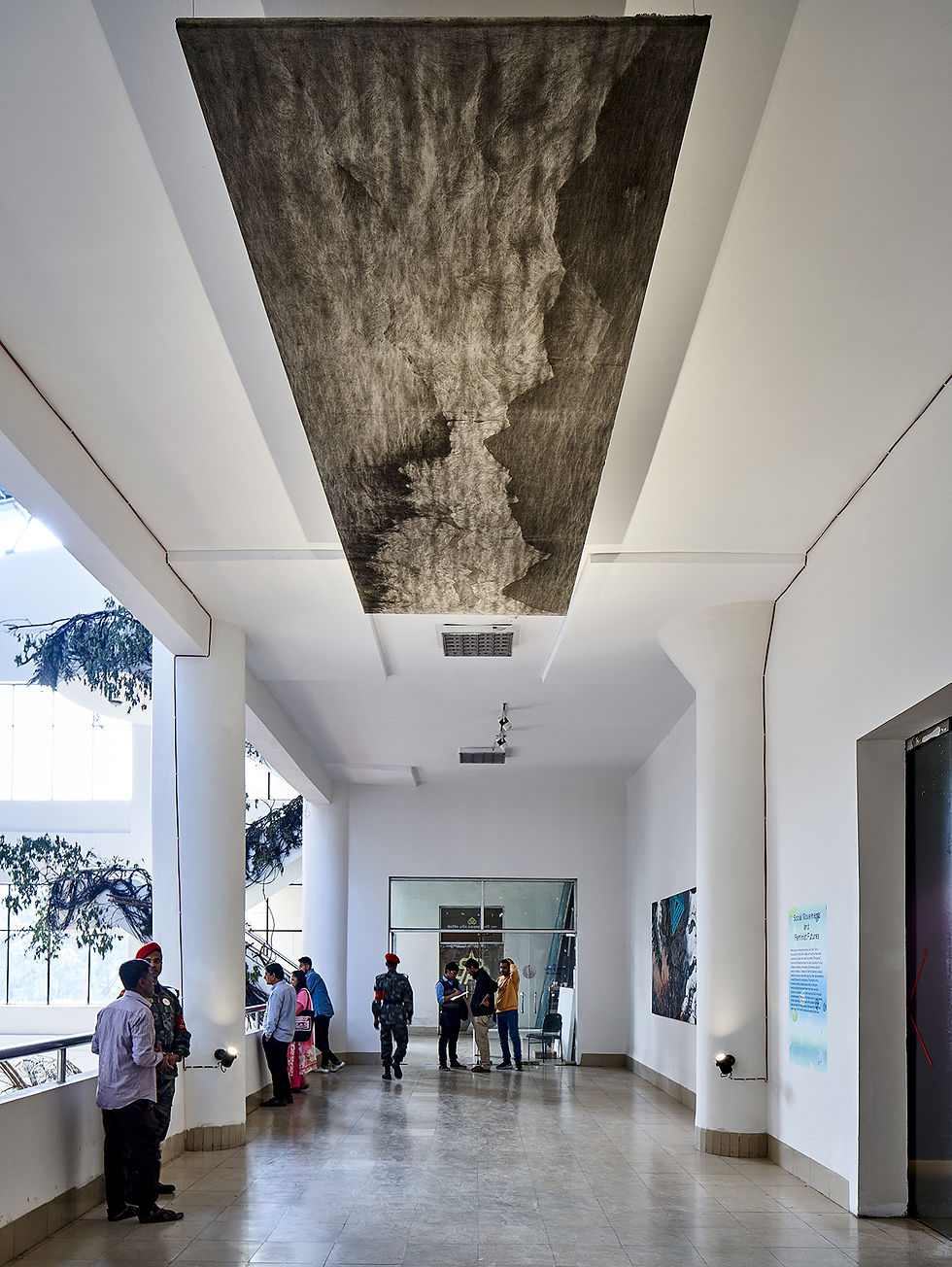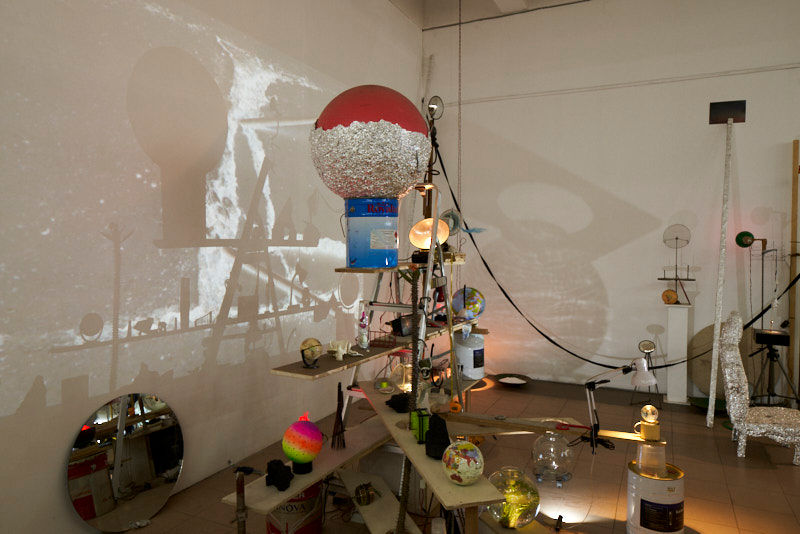Universes exist within us and universes exist beyond us. We inhabit our bodies; our bodies inhabit dwellings; and our imaginations inhabit limitless realms free from our mortal limitations. The artists in this movement explore the spaces that we move through (physical, social, political, discursive) and the ways we are able to transmit stories and knowledge across (life)times, building bridges from past to present to future. These stories and the belief and value systems embedded in them often speak to how humanity related to physically inaccessible worlds below the earth’s crust and beyond the sky. Certain works of art have the transformative power to make us feel and understand what is at stake, inspiring us to take action and bring new worlds into being. Your movement through the Bangladesh Shilpakala Academy was carefully considered in our design of the Summit, contributing to the activation of artworks and ideas found across the venue. By sharing your experience with others both in physical and digital space, we can make history together.

Clarissa Tossin
b. 1973, Porto Alegre; lives and works in Los Angeles
A Queda do Céu (The Falling Sky), 2019*
Laminated archival inkjet prints and wood
*after Yanomami leader Davi Kopenawa’s autoethnography, and cosmoecological manifesto.
Commissioned and produced by Samdani Art Foundation for DAS 2020. Courtesy of the artist, Commonwealth and Council, and Samdani Art Foundation
A Queda do Céu (The Falling Sky), 2019, Laminated archival inkjet prints and wood, Commissioned and produced by Samdani Art Foundation for DAS 2020, Courtesy of the artist and Commonwealth and Council.
When we talk about environmental concerns relating to the Amazon, we must consider its native peoples as part of the ecology. For instance, the terra preta, or black soil–the most fertile in the Amazon Basin–is a product of long-term indigenous land management practices, going back to ancient times. Discoveries such as this expand our perception of the forest beyond wild land myths and re-signify the ‘jungle’ as a result of human interactions with nature over time. The Amazon rainforest has been the recurring subject of Clarissa Tossin’s work, providing a rich study in the impacts of global commodity chains and by extension, the perpetuation of colonial forces enacted on the region’s environment, cultures, and people. A Queda do Céu (The Falling Sky) further engages with themes of ecological precarity and social justice. The weavings combine satellite images of the recent fires in Amazônia with Nasa images of the Mars plane named after the forest (Amazonis Planitia), the Amazon River and the Milky Way. The patterns were made to resemble the geometric partition of land created by agribusiness mostly visible from satellite images or bird’s-eye view. The triptych suggests a constellation of planets that project ambiguous visions of futurity, post-human landscapes and the ruins of a world yet to come.
Clarissa Tossin uses installation, video, performance, sculpture, and photography to negotiate hybridisation of cultures and the persistence of difference. By embracing semantic displacements in given material cultural ecosystems, Tossin’s work reflects on circulation from the level of the body to the global industry.
Korakrit Arunanondchai and Alex Gvojic
b. 1986, Bangkok; lives and works in New York and Bangkok
b. 1986, Chicago; lives and works in New York
Together (Dhaka Edition), 2019–2020
Clay, Electrical Wires, Leaves and Branches activated by performance with video and sound
Performance is active at 7pm on 7–8 February
Commissioned and Produced for by Samdani Art Foundation for DAS 2020. Courtesy of the artists, BANGKOK CITYCITY GALLERY, C L E A R I N G, Carlos/Ishikawa. Realised with additional support from MAIIAM Contemporary Art Museum. Presented with in-kind support from BANGKOK CITYCITY GALLERY
Rising up three-storeys of the DAS venue, Korakrit Arunanondchai’s monumental sculpture of a ‘naga’ (a reincarnating deity found across the mythology of South and Southeast Asia that shifts between snake and human form) transforms into a stage for the artist’s newest performance work in collaboration with Alex Gvojic that connects the river-based histories of Bangladesh and Thailand. Arunanondchai will create a soundscape within an environment based on Ghost Cinema, a post-Vietnam War ritual in Thailand where outdoor screenings function as communions between the audience and the spirits. Introduced by American soldiers stationed in Thailand who screened films in the forests, creating enigmatic projections which locals attributed to ghosts, the appropriation of the ritual by locals reflects the rich history of military coups and their effect on local folklore and rituals.
Arunanondchai works with performance, video, and installation, addressing the crossing over of themes like family, superstition, spirituality, history, and politics. With an interest in collaboration, he transforms gallery spaces into arenas of connections, personal and cross-cultural. These allow him to explore relationships in recorded history while sidestepping its preoccupation with linear narratives. Alex Gvojic specialises in the interdisciplinary crossing of art, fashion, and music. Within his breath of multimedia projects, which span from entertainment production to environmental design, each embodies a signature sharpness in both imagery and concept.

Minam Apang
b. 1980, Naharlagun; lives and works in Goa
Sisyphean Sea, 2019
Charcoal on Canvas
Commissioned for DAS 2020
Courtesy of the artist and Chatterjee and Lal
Minam Apang produces expansive intricate imaginary landscapes that reveal her spiritual connection to who she is and where she comes from. The artist moved from Arunachal Pradesh to Goa, mirroring the migration of large numbers of youth from Northeast India who are forced to leave due to a rampant military presence and the consequent lack of employment opportunities. Apang’s savage yet delicate drawing registers this trauma, reimagining it at a mythical scale suspended above the heads of viewers. The sea seems to lay siege to the mountains, tilting the axis of the world – alluding to the conflicted landscape of Arunachal Pradesh, but also to the many chapters of change that our planet has experienced: the same Himalayas that are melting today were once completely underwater.
Apang’s practice predominantly employs drawing with charcoal. In early works, she painted scenes inspired by the folktales and myths passed down orally by her tribe in Arunachal Pradesh. More recently, her landscapes and figures are drawn from imagination and informed by hybrid experiences of the landscapes she has inhabited.
Mizanur Rahman Chowdhury
b. 1981, Noakhali; lives and works in Dhaka
LOVE LETTER TO THE LAST SUN, 2019–2020
Mixed media
Commissioned and produced by Samdani Art Foundation for DAS 2020. Courtesy of the artist and Samdani Art Foundation
This newly commissioned interactive installation is composed of a combination of everyday objects and natural elements (fire, water, earth, air) and aims to recalibrate the ecological co-existence of human and non-human living organisms in our universe. The work resides between fiction and reality, between the conceptual and the concrete, between an imagined reality and the construction of it. It fights against normative expectations. The progress of modernity is leading us towards the great destruction of this planet. Through Mizanur Rahman Chowdhury’s use of cameras and projectors, the viewer is able to locate her/himself within the web and connectivity of a total magnetic force, while perceiving the energetic pulses of the universe. Immersing the viewer in his utopian world, s(he) is re-connected with planets and other beings, both human and not.
Chowdhury’s interdisciplinary practice plays with different media, ranging from installation, assemblage, video, collage, sculpture, found footage, experimental film and more to conjure a multifaceted artistic universe. By creating unfamiliar space and situations for everyday mundane objects, Chowdhury creates unique interpretations while engaging new experimental territories with vast potentials.

Subash Thebe
b. 1981, Nepal; lives and works in London
NINGWASUM- Moving Across
Time and Space, 2019
Acrylic on canvas
Commissioned for DAS 2020
Courtesy of the artist
Memories of possible and not so possible events woven into stories have been a fundamental way of accessing and disseminating knowledge to future generations in almost all indigenous communities, including Subash Thebe’s Limbu community. In a sense, memory is more significant for the future than for the past. The glacial lakes in Subash Thebe’s new painting are rendered in actual and imaginary time frames; sometimes they freeze back into glaciers and other times they grow bigger. At times, the Himalayas are rich with snow and glaciers and at other times they are nothing but grey tectonic rocks. There’s a spaceship in the frame, its shape inspired by the object called ‘Silamsakma’ commonly used in Limbu rituals. This memory of its existence in the future explores implications previously unimaginable.
Thebe works with sound, film, music, performance, painting, and podcasts, exploring the relation between art and social change. He records the sound and images of his public engagements to later incorporate them in his works. His work is inspired by science fiction, future scenarios of struggle, resistance, climate change, and indigeneity.

William Forsythe
b. 1949, New York
Fact of Matter, 2009
Polycarbonate rings, polyester belts, ground support rigging
Courtesy of the artist. Presented with additional support from ifa | Institut für Auslandsbeziehungen and the EMK Center. The development and international exhibition of Choreographic Objects by William Forsythe is made possible with the generous support of Susanne Klatten
Fact of the Matter, one of William Forsythe’s ‘Choreographic Objects’, poetically speaks to the interplay of collective and individual experience in navigating the world and its challenges and forms of thinking that can be activated through movement. The object is not so much there to be seen as to be used, and engaging with the object and the artist’s instructions gives the user a new perspective of the self as they become aware of their body’s mass, strength, and coordination as a unified system. These three qualities are not as unified as we would like them to be, and we invent strategies to pull through what might seem like an unnavigable space while learning from the strategies devised by other people using the object.
Forsythe is known for his radical innovations in choreography and dance. His deep interest in the fundamental principles of organisation has led him to produce a wide range of projects. Parallel to his career as a choreographer, he creates installations, film works, and interactive sculptures, known as ‘Choreographic Objects’.










